How To Draw A Path In Google Earth
Introduction to Map Projections with Google Globe Engine: Function 1
The Earth is round, but your computer screen is flat. A map projection describes how points on a plane, such as the pixels on your screen, correspond to points on the surface of the Earth.
Let'south explore how this works using a global state comprehend dataset known as MCD12Q1, one of many standard data products made with data from NASA's MODIS satellite instruments. This dataset is hands bachelor in Google Earth Engine, a cloud platform for geospatial data analysis, and if y'all similar yous tin follow along with this simple script on GitHub to run across how I made all the images in this commodity.
First permit's take a expect at this dataset in its native map projection:
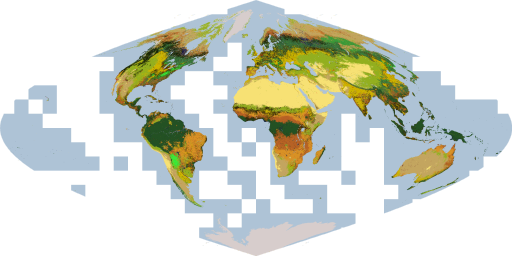
This data uses a sinusoidal project, which is an example of an equal-area projection: each pixel corresponds to an area of equal size on the surface of the Earth. For that reason, and because of its simple mathematical form, NASA produces and distributes many of its global datasets in this projection. (The foursquare blocks in the oceans represent no-data areas in this particular dataset.)
All data in the World Engine public data catalog is stored in its original map projection, in this case sinusoidal. However, yous tin easily resample the data into other map projections for assay or visualization. Permit'southward take a look at this data in a some other mutual projection, the equirectangular projection:
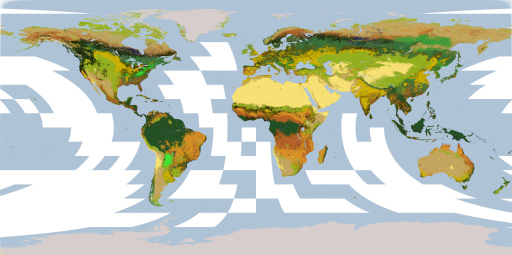
This projection, sometimes too referred to as plate carrée, is commonly used because the math is especially uncomplicated: the axes represent directly to latitude and longitude. Notice, however, that the areas near the pole appear stretched out horizontally. This projection does not preserve either shapes or areas. In that location is no perfect way to flatten out a sphere, and and then people have created many unlike map projections over the years, each of which makes different compromises and is appropriate for different uses.
To compensate for this distortion about the poles, yous might exist inclined to stretch those regions vertically likewise. If you do that merely correct then you get some other famous map projection that does preserve local shapes and angles, although it certainly does not preserve areas. This is the Mercator projection:
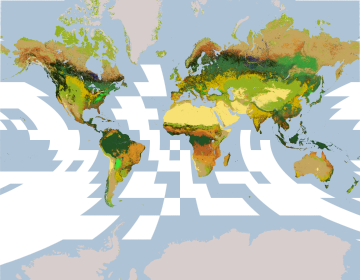
This projection radically distorts the relative area of land masses, making regions that are farther from the equator appear much larger than they actually are. For example, it makes Greenland appear comparable in size to Africa, when in fact information technology is only ane 3rd the size of Commonwealth of australia! The Mercator projection has its advantages, though, one of which nosotros'll see shortly.
Nosotros've been looking at global data, but let's see what happens when nosotros zoom in on the continental United States. Start allow's render to this land cover dataset's native sinusoidal projection:
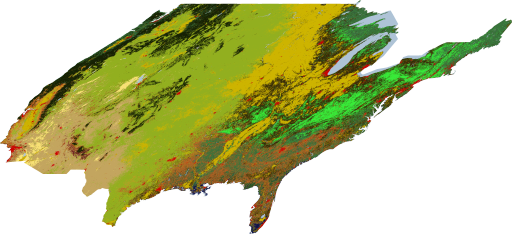
Conspicuously the sinusoidal projection is a poor choice for presenting this country-scale information. The situation improves somewhat if we use an equirectangular projection instead:
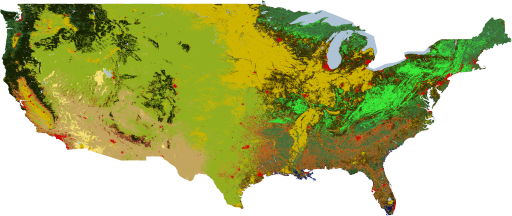
However, the The states is still visibly stretched horizontally. If you like the simplicity of this project, and if y'all are focusing on a local surface area, then y'all can approximately counteract this baloney by scaling the entire projection horizontally. If you exercise this, so any local surface area besides starts to look a lot like the Mercator project:
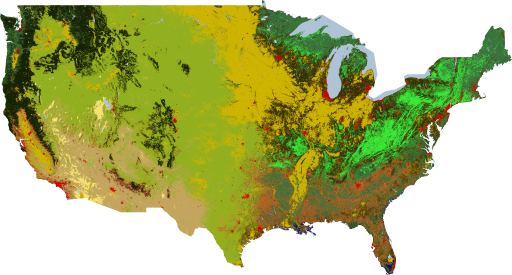
You may recognize this view of the United States, since information technology is exactly the project used by Google Maps and other web mapping services. There is adept reason for this. You tin derive the Mercator projection from just a few desirable characteristics: north is always up, eastward is always to the right, and if you lot zoom into whatsoever surface area the local shapes and angles will be right. The Mercator projection achieves this local-calibration universality at the cost of the pregnant global-calibration distortions that we saw in a higher place.
The continental Usa is big plenty that these expanse distortions are even so significant. In item, the northern states announced besides large relative to the southern states. Every bit a upshot, maps of the United States usually do not use whatever of the projections we've discussed so far. One mutual choice is the Albers projection:
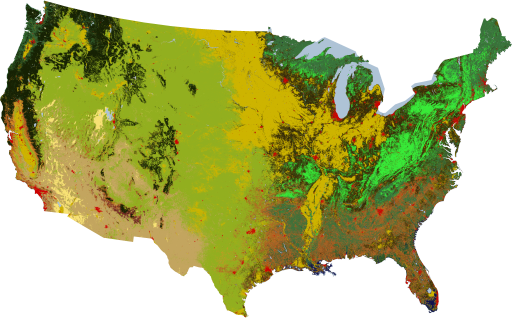
This is another example of an equal-surface area projection, so it represents the relative areas of all the states accurately. Detect that the northern border of the western US no longer appears as a straight line, even though it runs due east/west. In a sense this is really a more accurate flick: because of the curvature of the Earth, the shortest path from northern Washington state to northern Minnesota really does laissez passer through Canada.
If you found this interesting, you might savour learning even more than about these issues in Michael Corey's Source commodity, Choosing the Right Map Projection. We'll dive deeper into the details and look at a few other projections in Part 2.
Source: https://medium.com/google-earth/introduction-to-map-projections-with-google-earth-engine-part-1-7840e4ca6264
Posted by: robertsonbeirch1984.blogspot.com


0 Response to "How To Draw A Path In Google Earth"
Post a Comment